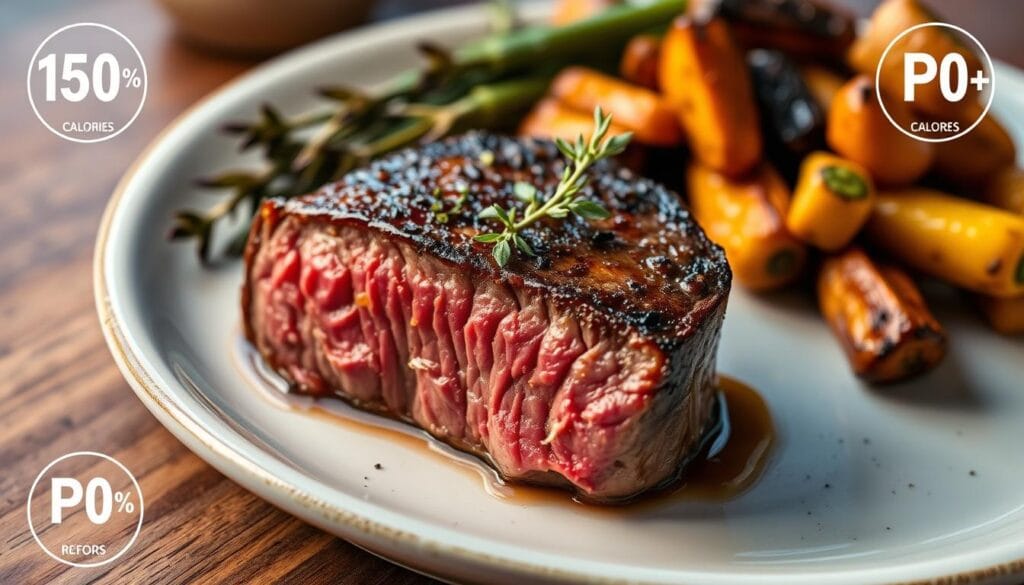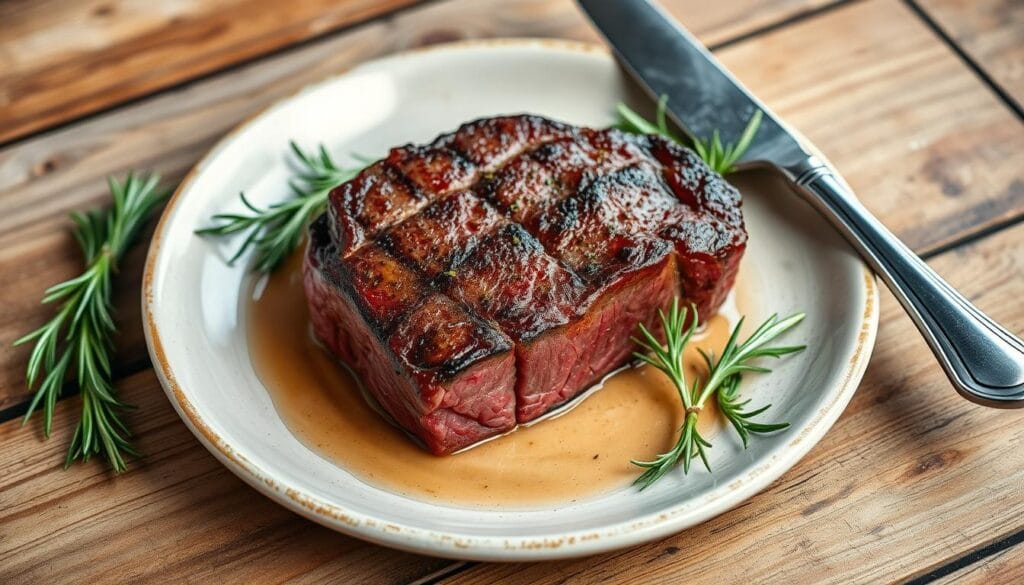I love steaks, and filet mignon is my favorite. This tender and delicious cut is not only flavorful but also low in filet mignon calories, making it a great choice for health-conscious food lovers. Let’s explore how this premium steak fits into a balanced diet.
Table of contents
Key Takeaways
- A 5 oz serving of filet mignon contains 160 calories.
- Filet mignon is a lean, high-protein cut of beef with minimal carbs.
- It’s an excellent source of essential nutrients like iron, potassium, and B-complex vitamins.
- Proper cooking methods and portion sizes are important for managing the caloric impact of filet mignon.
- Filet mignon can be a nutritious addition to a balanced diet when consumed in moderation.
Understanding Filet Mignon: A Premium Cut of Beef
Filet mignon is a top choice for its tenderness and lean profile. It comes from the beef tenderloin, making it a hit with those who care about their health. It’s packed with protein, making it a great option for a meaty meal.
What Makes Filet Mignon Special
Its special place in the animal makes filet mignon stand out. It’s from the tenderest part of the beef tenderloin, with little connective tissue. This makes it leaner, with fewer lean red meat calories and less fat than other steaks.
Location and Characteristics of the Cut
The filet mignon is at the smaller end of the tenderloin, near the spine. This spot is less active, which adds to its tenderness. A typical steak weighs 4 to 8 ounces, perfect for a filling and protein-rich meat meal.
Quality Grades and Selection
Choosing the right filet mignon means looking at USDA quality grades. Prime and Choice grades have more marbling, which boosts flavor and juiciness. Marbling is fat in the muscle, key to quality and taste. Knowing these grades helps you pick the best filet mignon.

Filet Mignon Calories and Basic Nutritional Profile
Filet mignon is a top pick for those watching their calories. A 5-ounce serving has only 160 calories. It also has just 3 grams of fat, with 1.5 grams being saturated.
This cut of beef is not just low in calories. It’s also high in protein with 31 grams. Plus, it’s low in sodium with only 65 milligrams per serving. It’s also rich in iron and potassium.
| Nutrient | Amount per 5 oz Serving |
|---|---|
| Calories | 160 |
| Total Fat | 3 g |
| Saturated Fat | 1.5 g |
| Protein | 31 g |
| Carbohydrates | 0 g |
| Sodium | 65 mg |
| Iron | 4.1 mg |
| Potassium | 570 mg |
Filet mignon is great for those looking for a lean beef option. It’s high in protein and low in calories. This makes it a good choice for many diets.

Protein Content and Amino Acid Profile
Filet mignon is packed with high-quality protein, offering 31 grams per 5 ounce serving. It has all the essential amino acids, making it perfect for building and repairing muscles.
Essential Amino Acids in Filet Mignon
Filet mignon is full of the nine essential amino acids our bodies can’t make. It has leucine, isoleucine, and valine, key for muscle-building proteins. It also has lysine, methionine, phenylalanine, threonine, tryptophan, and histidine.
Protein Quality for Muscle Building
The protein in filet mignon is easily absorbed by the body. It’s a top choice for muscle growth and recovery. Adding it to your diet can help meet your protein needs for an active life.
Daily Protein Requirements and Portion Sizes
A 5 ounce serving of filet mignon meets a big part of your daily protein needs, which are 46-56 grams for adults. For those aiming for lean muscle mass, a 6-8 ounce portion is great for meals.

“Filet mignon is a prime example of a high-quality protein that can support your fitness goals and overall health.”
Fat Content and Types of Fats
When it comes to red meat, filet mignon is a low-fat choice. A 5-ounce serving has only 3 grams of total fat. This includes 1.5 grams of saturated fat and 1.5 grams of monounsaturated fat, which is good for your heart. This makes filet mignon a great choice for those who want to enjoy red meat without too much fat.
Filet mignon is one of the low-fat meat options compared to other beef cuts. For example, London Broil has 7 grams of fat per 100 grams. Meanwhile, New York Strip Steak has 6 grams. Other diet-friendly steaks include Bottom Round Steak with 8 grams of fat and Top Sirloin Steak with 11 grams. This makes filet mignon a healthier choice for those watching their fat intake.
“Nearly half of Americans report consuming steak at least once a week, according to a survey by the National Cattlemen’s Beef Association.”
The fat in filet mignon is also good for your heart. It’s rich in monounsaturated fats. This, along with its low fat content, makes it a good choice for a balanced diet.

Knowing the fat profile of filet mignon and other healthy red meat choices helps you make better meal plans. This way, you can stay healthy and enjoy a diet-friendly lifestyle.
Vitamins and Minerals in Filet Mignon
Filet mignon is a top-notch beef cut that’s both tasty and nutritious. It’s packed with vitamins and minerals that boost your health.
Iron and Heme Iron Content
A 5-ounce filet mignon gives you 51% of your daily iron. It’s rich in heme iron, which your body absorbs well. This is great for keeping iron levels up, especially for those who are active or follow a healthy diet.
B-Complex Vitamins
Filet mignon is also full of B-complex vitamins. These vitamins help with energy, nerve health, and making red blood cells. A 5-ounce serving gives you a big chunk of your daily B6, B12, and niacin needs. This supports your metabolism and energy levels.
Mineral Profile Analysis
Filet mignon is not just high in iron. It also has lots of potassium and zinc. Potassium helps keep blood pressure in check, and zinc is key for a strong immune system and healing wounds.
For those watching their steak portions and choosing healthy beef, filet mignon is a top pick. Its high iron, B-vitamins, and minerals make it a nutritious choice for steak lovers.
Portion Sizes and Caloric Impact
Enjoying filet mignon means watching your portion sizes to keep calories in check. A 5-ounce serving has about 160 calories. But, a 16-ounce portion can have up to 621 calories. Knowing these sizes is key to adding this lean meat to a healthy diet.
Steak is packed with protein, which helps build and repair tissues. It also helps with weight loss by keeping you full longer. Opting for lean cuts like sirloin tip and top round can help with weight loss since they have less fat and calories.
| Steak Cut | Calories per 4 oz Serving | Saturated Fat (g) |
|---|---|---|
| Filet Mignon | 160 | 6 |
| Ribeye | 272 | 9 |
| Sirloin | 184 | 4 |
Cooking steak healthily, like grilling or baking, can lower calories and aid in weight loss. It’s also important to avoid high-calorie sauces and toppings to keep steak meals healthy.
By understanding portion sizes and choosing the right cuts, you can enjoy filet mignon without overdoing it on calories.
Comparing Filet Mignon Calories to Other Cuts
Filet mignon is a top choice in fine dining for its tenderness and flavor. But how does it compare to other steaks in calories and nutrition?
Ribeye vs. Filet Mignon
Ribeye is loved for its rich taste and marbling. But, it has more fat and calories. A 3-ounce ribeye has 22 grams of fat and 240 calories. In contrast, filet mignon has 9 grams of fat and 185 calories in the same size.
Sirloin vs. Filet Mignon
Sirloin is cheaper but has more calories than filet mignon. A 3-ounce sirloin has 16 grams of fat and 210 calories. Filet mignon is leaner, making it better for those watching calories.
| Steak Cut | Calories (per 100g) | Fat (grams per 100g) | Protein (grams per 100g) |
|---|---|---|---|
| T-Bone | 271 | 16 | 24 |
| Porterhouse | 293 | 20 | 24 |
| Sirloin | 252 | 16 | 27 |
| Filet Mignon | 258 | 17 | 26 |
| Rump | 172 | 10 | 21 |
| Flank | 172 | 8 | 28 |
| Skirt | 193 | 12 | 26 |
| Brisket | 109 | 7 | 21 |
| Flat Iron | 140 | 6 | 20 |
| Tomahawk | 220 | 13 | 22 |
| Rib-Eye | 293 | 22 | 24 |
This comparison shows filet mignon is leaner than ribeye and sirloin. Knowing these differences helps you choose healthier options for your diet.
Health Benefits of Lean Beef Consumption
Lean beef, like filet mignon, is great for a healthy diet. It’s full of protein and vitamins that help your body stay healthy. Eating lean beef can make your diet more nutritious.
Lean beef is packed with protein. A 4-ounce serving of lean sirloin steak has about 23 grams of protein. This is perfect for building and keeping muscle. Your body can easily use this protein for many functions.
Lean beef is also a good source of iron. Iron is key for making healthy red blood cells. Iron deficiency is common worldwide. Eating lean beef helps ensure your body gets enough iron.
Lean beef has many B-vitamins like niacin, vitamin B6, and vitamin B12. These vitamins help with energy, nerve function, and overall health. It also has zinc, which boosts your immune system by helping make white blood cells.
It’s important to eat lean beef in moderation. But the benefits are clear. Adding lean cuts like filet mignon to your diet can make your meals more nutritious. This helps you have a balanced diet.
| Protein Source | Protein (g per 4-oz serving) | Fat (g per 4-oz serving) |
|---|---|---|
| Lean Sirloin Steak | 23 | 5 |
| Skinless Chicken Breast | 26 | 3 |
| Low-fat Cottage Cheese | 14 | 1.5 |
| Lean Pork Loin | 23 | 4 |
| Bison | 24 | 2 |
| Egg Whites | 14 | 0.5 |
Lean meats like filet mignon, skinless chicken, and bison are great for a healthy diet. They have lots of protein but not much fat. This makes them perfect for a balanced diet.
Cooking Methods and Their Effect on Calories
Choosing how to cook your filet mignon can change its calorie count. Filet mignon is lean and low in calories. But, how you prepare it can affect its nutritional value.
Grilling vs. Pan-Searing
Grilling or broiling filet mignon is healthier than pan-searing with fats. The high heat in grilling or broiling melts out some fats. This makes the steak lower in calories.
On the other hand, pan-searing with oils or butter adds more calories. Each tablespoon of fat can add 120 calories.
Impact of Added Fats During Cooking
Some fat is good for flavor and texture in filet mignon. But, using too much can increase calories. A light coat of olive oil or a quick spray of non-stick spray helps keep calories down.
By using lean cooking methods and controlling fat, you can enjoy filet mignon’s flavor and texture. This way, you stay within the bounds of grilled filet nutrition and healthy steak preparation for a calorie-conscious dining experience.
Incorporating Filet Mignon into a Balanced Diet
Filet mignon is a top-notch beef cut that’s good for a balanced diet if eaten in small amounts. It’s packed with protein and has less fat, fitting well into low-carb and high-protein diets. Pairing it with veggies and whole grains makes for a meal that’s both tasty and healthy.
A 3-ounce cooked filet mignon has about 185 calories, 23 grams of protein, and 9 grams of total fat. It has 3.5 grams of saturated fat, 4 grams of monounsaturated fat, and 0.4 grams of polyunsaturated fat. This makes it a diet-friendly steak because it’s high in quality protein but low in calories and fat.
To make filet mignon part of a balanced diet, here are some tips:
- Stick to the recommended 3-4 ounces per meal to control portions.
- Try pairing it with other healthy red meat choices like lean sirloin or flank steak for variety.
- Balance your meal by adding a lot of roasted veggies like Brussels sprouts, asparagus, or zucchini.
- Add a small amount of complex carbs like brown rice or quinoa to round out your meal.
By following these tips, you can enjoy filet mignon’s taste and health benefits while keeping your diet balanced and diet-friendly.
Restaurant Portions vs. Home-Cooked Servings
Filet mignon portions at restaurants are often too big. They usually serve 8-12 ounces, but you should only eat 3-4 ounces. This makes it hard to eat healthy when you’re out.
Cooking filet mignon at home lets you control the size. You can serve it in the right amounts, helping you eat fewer calories. This way, you can enjoy healthy steak without eating too much.
Standard Restaurant Portions
Restaurants often give big portions to make you feel like you’re getting a good deal. But these large servings can lead to eating too many calories. This makes it hard to eat well.
Recommended Home Serving Sizes
At home, you can stick to the 3-4 ounce serving size. This lets you enjoy the steak’s flavor without overeating. It helps you keep your calorie intake down.
| Metric | Restaurant Portion | Recommended Home Serving |
|---|---|---|
| Filet Mignon Portion Size | 8-12 oz | 3-4 oz |
| Approximate Calories | 500-750 calories | 200-300 calories |
Being careful with portion sizes helps you enjoy healthy foods like filet mignon. Whether you’re eating out or at home, you can stay healthy and balanced.
Special Dietary Considerations
Filet mignon is a top choice for many diets. It’s low in carbs, making it great for keto-friendly and low-carb diets. It’s also lean, making it a top diet-friendly protein source for a healthy lifestyle.
For those watching their fat intake, filet mignon is a good option. It has less fat than other beef cuts. This means you can enjoy a protein-rich meal without feeling guilty about fat.
But, people with heart disease or high cholesterol should talk to their doctor before eating red meat. This includes filet mignon. It’s important to eat it in moderation and control your portions.
“Filet mignon is a versatile protein that can be enjoyed as part of a balanced diet, regardless of your specific dietary needs.”
Being careful with portion sizes and cooking methods is key. This way, you can enjoy filet mignon while sticking to your diet. It’s a tasty and healthy choice for keto-friendly, low-carb, or low-fat diets.
Conclusion
Filet mignon has 160 calories in a 5 oz serving. It’s a mix of great taste and good nutrition. Its high protein and essential nutrients, along with low fat, make it good for many diets. Knowing its filet mignon calories helps you add it to a healthy, balanced diet while watching calories.
Looking to build muscle or just enjoy a tasty steak? Filet mignon is a nutritious and delicious choice. Choose the right portion and cooking method to enjoy its healthy steak option and amazing flavor.
Remember the filet mignon calories and match it with your diet needs. This way, you can enjoy this premium cut in your meals. It lets you enjoy great food while keeping your health and wellness goals in mind.
FAQ
What is the calorie content of filet mignon?
A 5 oz (140g) serving of beef filet mignon steak has 160 calories.
What is the nutritional breakdown of filet mignon?
A 5 oz serving of filet mignon is 5% carbs, 17% fat, and 78% protein. It’s packed with protein (55% DV), potassium (12% DV), and iron (51% DV).
What makes filet mignon a premium cut of beef?
Filet mignon is tender and lean. It has less fat than other cuts, making it a favorite for those watching their diet.
How do the different quality grades affect filet mignon?
Quality grades for filet mignon include Choice and Prime. Marbling is a key factor in choosing the best.
What is the protein content and amino acid profile of filet mignon?
A 5 oz serving of filet mignon has 31g of protein. It has all essential amino acids. This makes it great for building and repairing muscles.
How much fat is in filet mignon?
A 5 oz serving of filet mignon has 3g of total fat. This includes 1.5g of saturated fat and 1.5g of monounsaturated fat. It’s a lean cut of beef.
What are the key nutrients found in filet mignon?
Filet mignon is rich in iron (51% DV), potassium (570mg), and B-complex vitamins. These nutrients help balance your diet.
How do portion sizes affect the caloric content of filet mignon?
Portion sizes greatly affect filet mignon’s calories. A 5 oz serving has 160 calories. A 16 oz portion would have about 621 calories.
How does filet mignon compare to other beef cuts in terms of calories and fat?
Filet mignon has fewer calories and fat than cuts like ribeye or sirloin. A 5 oz serving of filet mignon has 160 calories and 3g of fat. Ribeye may have much more.
What are the health benefits of including filet mignon in a balanced diet?
Lean beef like filet mignon is full of health benefits. It’s a great source of protein for muscle maintenance and growth. It also has high iron for healthy blood and B-vitamins for energy.
How does cooking method affect the caloric content of filet mignon?
Cooking methods can change filet mignon’s calories. Grilling or broiling add fewer calories than pan-searing with oil, which can add 120 calories per tablespoon.
Can filet mignon be part of a balanced diet?
Yes, filet mignon can be part of a balanced diet when eaten in moderation. Its high protein and low fat make it good for various diets, like low-carb and high-protein ones.
How do restaurant portions compare to recommended serving sizes for filet mignon?
Restaurant portions of filet mignon are often too big. A typical portion is 8-12 oz, while a recommended serving is 3-4 oz. Cooking at home helps control portions better.
Is filet mignon suitable for special dietary needs?
Yes, filet mignon is good for many diets. It’s low in carbs, making it great for low-carb and ketogenic diets. Its lean profile also suits low-fat diets.






